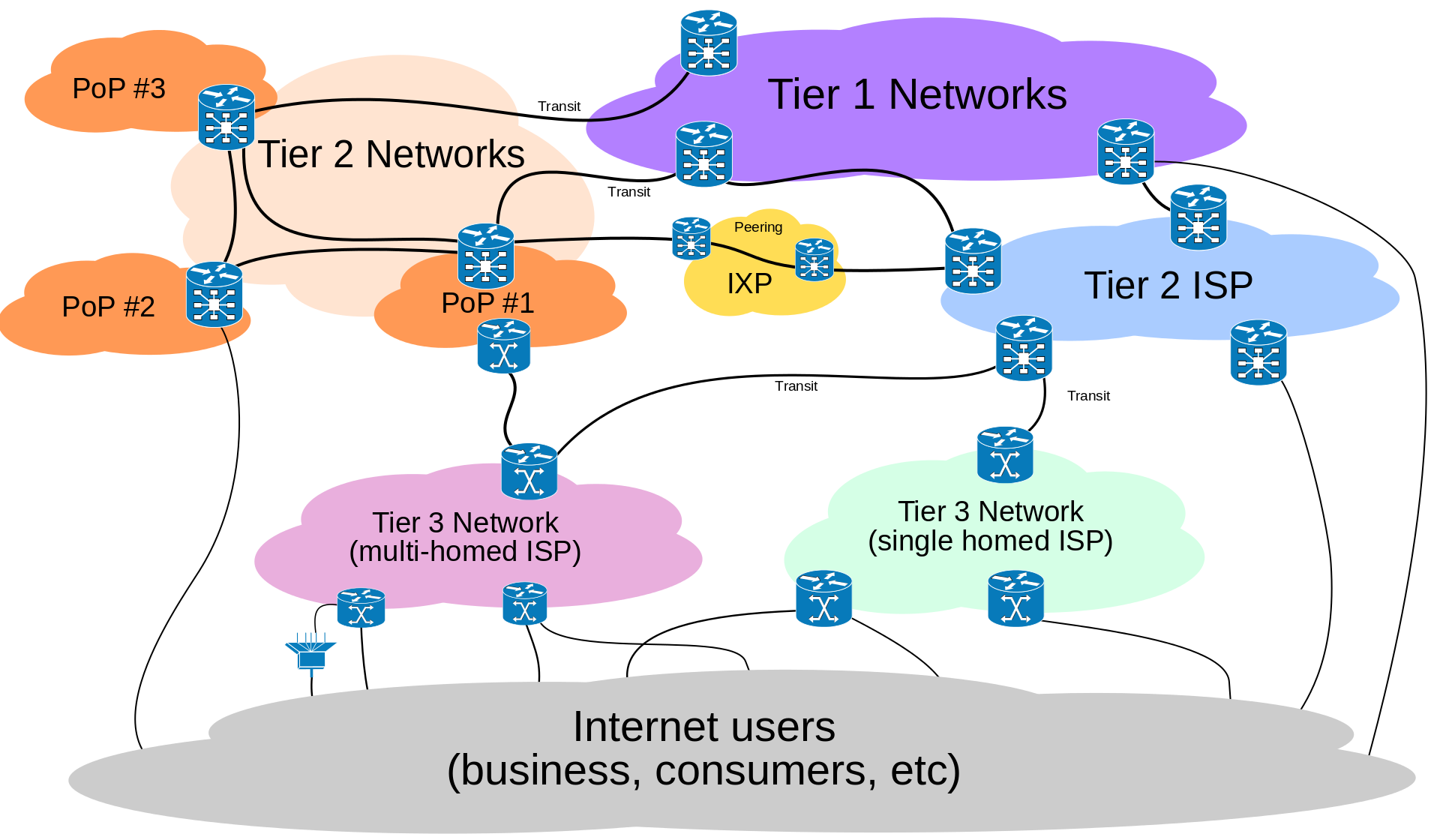Understanding Networks
Traceroute
I "tracerouted" google.com, facebook.com, 1023.io, netflix.com, itp.nyu.edu, tv.sohu.com, and taobao.com in school and at my place. One thing that is worthy to mention is that except google and facebook, when I used terminal to traceroute, they all failed to find routes after 64 routes. But when I use this website to "proxy trace" traceroute(http://www.yougetsignal.com/tools/visual-tracert), they all succeeded.
According to this image, Proxy Trace passed yougetsignal.com, but when I traceroute in my laptop terminal, traceroute didn't passyougetsignal.com. So I suppose that yougetsignal.com may optimize the traceroute method.
When I trace route at school, the routes that show every time are NYU.EDU, yipes.com, 62.216.147.186, telia.net, 198.199.99.241, 107.170.234.253, 198.199.99.253.
(note: TeliaSonera AB is the dominant telephone company and mobile network operator in Sweden and Finland. The company has operations in other countries in Northern, Eastern Europe, Central Asia, South Asia and Spain, with a total of 182.1 million mobile customers (Q1, 2013).)
When I trace route at home, the network providers that show every time are comcast.net and telia.net.
(note: Comcast Corporation is an American mass media company and is the largest broadcasting and cable company in the world by revenue. It is the largest cable company and homeInternet service provider in the United States, and the nation's third largest home telephone service provider. Comcast services U.S. residential and commercial customers in 40 states and the District of Columbia. The company is headquartered in Philadelphia, Pennsylvania.)
The major tier 1 providers in my life is telia.net.
Note: tier 1 network. The most common definition of a tier 1 network is a network that can reach every other network on the Internet without purchasing IP transit or paying settlements. I found this image in wikipedia.
A tier 2 network is an Internet service provider who engages in the practice of peering with other networks, but who also purchases IP transit to reach some portion of the Internet.
(IP transit: Internet transit is the service of allowing network traffic to cross or "transit" a computer network, usually used to connect a smaller Internet service provider (ISP) to the larger Internet.)
(Peering: In computer networking, peering is a voluntary interconnection of administratively separate Internet networks for the purpose of exchanging traffic between the users of each network. )
The term tier 3 is sometimes also used to describe networks who solely purchase IP transit from other networks (typically tier 2 networks) to reach the Internet.)
Understanding Networks reading response
According to the example in the article "Why Google Went Offline Today and a Bit about How the Internet Works", we can see the fact that the Internet is a system built on trust.
My note:
AS: the Internet is a collection of networks, known as "Autonomous Systems" (AS). Each network has a unique number to identify it known as AS number.
BGP: the networks are connected together by what is known as Border Gateway Protocol (BGP). BGP is the glue of the Internet — announcing what IP addresses belong to each network and establishing the routes from one AS to another. An Internet "route" is exactly what it sounds like: a path from the IP address on one AS to an IP address on another AS.
BGP Trust model: BGP is largely a trust-based system. Networks trust each other to say which IP addresses and other networks are behind them. When you send a packet or make a request across the network, your ISP connects to its upstream providers or peers and finds the shortest path from your ISP to the destination network.
"Route leakage": the route has "leaked" past normal paths. Unfortunately, if a network starts to send out an announcement of a particular IP address or network behind it, when in fact it is not, if that network is trusted by its upstreams and peers then packets can end up misrouted.
Example: someone at Moratel likely "fat fingered" an Internet route. PCCW, who was Moratel's upstream provider, trusted the routes Moratel was sending to them. And, quickly, the bad routes spread.
Reading Response — Understanding Networks Week 1
The author of "The Linked" starts with two examples - MafiaBoy and Paul. Though MafiaBoy is an act of destruction and he operates the Internet, Paul built a wide early Christian communities and he operates social network, They both used networks to increase their impact dramatically. Their success depends on the fact that "everything touches everything". In the first chapter, the author also talks about the opposite research method to reductionism. Cause in complex system the parts can be put together in many different ways, the simple "divide and conquer" method is not enough anymore. Instead of seeing things in isolation, we need to see the world where most events and phenomena are connected.
After the first chapter, I was convinced by the author. I became excited about the new science of networks. It not only about the Internet, it's also about social network, neurology, and other diverse systems that all share some similarities.
The third chapter tells the whole background story of Six Degrees of Separation, which suggests that people are linked by at most 5.5 links. Six Degrees of Separation is intriguing, because no matter how enormous our society is, it can easily be navigated by following social links between people. That is, our world is actually quiet small because of its dense web.
In addition, the Web is small world too. Network’s diameter is a function of the number of nodes, and the diameter of the Web was 18.59, close to 19. So here comes nineteen degrees of separation. Also, the Internet, a network of hundreds of thousands of routers, has a separation of ten. The reason for these theories exit is that these networks are highly interconnected. However, the author pointed out that these theories have limitations. It must be shorter than six people cause Milgram's subject didn't know the shortest path to their target.
In conclusion, in general, networks is genetically "small", but our ability to reach a node has less to do with the physical distance. So we need a new geometry to understand the complex networks.
This remind me of the development of NYC subway map. At first, the map is analogical. It shows all the actual distance between two nodes and the precise position of each node. However, this map is confusing to people. People don't need to know that details. So the new map simplified nodes and links, and emphasized the relationships of nodes. The new map is much more easy for people to understand.

